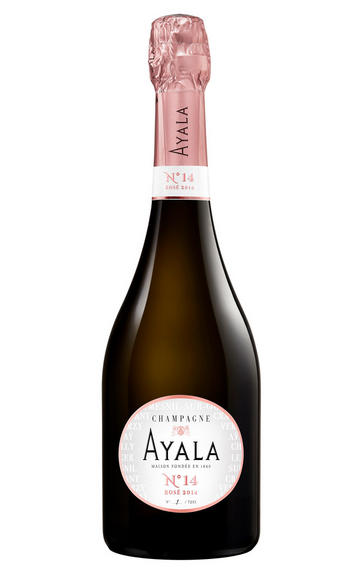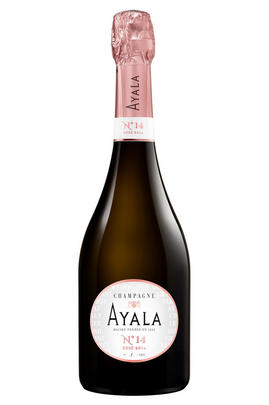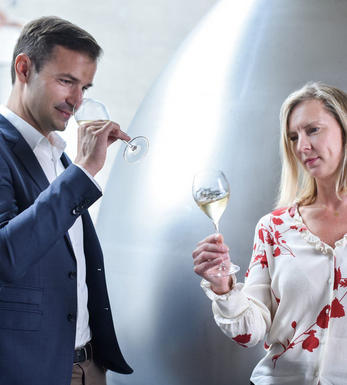
2014 Champagne Ayala, No. 14, Rosé, Extra Brut

Critics reviews
The 2014 Rosé is a rich, vinous Champagne. Sweet red cherry, kirsch, spice and mint are nicely pushed forward. Time in the glass releases lovely inner sweetness to round things out. This is very nicely done.
Drink 2022 - 2027
Antonio Galloni, Vinous.com (May 2022)
Blend of wine from five grand cru villages Aÿ, Chouilly, Cramant, Le Mesnil-sur-Oger and Verzy. Third iteration of these limited-edition bottlings.
Pale coppery salmon pink. Pretty, perfumed nose. Excellent balance even if not that persistent a finish. Quite a dry finish but sufficient body to make this a champagne to consider serving with food.
Drink 2022 - 2026
Jancis Robinson MW, JancisRobinson.com (May 2022)
Plenty of strawberry character with iron, peaches and hints of chalk. Full-bodied with medium, round tannins and a spicy, cotton-candy and orange-peel aftertaste.
Drink now
James Suckling, JamesSuckling.com (August 2022)
60% Chardonnay and 40% Pinot Noir, with 5% of red wine. Dosage of 5.3 g/L.
An elegant and subtle bouquet of strawberry, lemon, mango and spring flowers. The palate is perfectly balanced, very pure and fresh, with a racy acidity that brings purity and tension to the finish.
Drink 2023 - 2030
Yohan Castaing, Decanter.com (October 2022)
A very different expression, the 2014 Champagne No 14 Brut Rosé is a pale peach hue, with a subtle and attractive perfume of lilac, tangerine, and cantaloupe. It has more racy and compact tension on the palate, with a soft, chalky texture that lifts cleanly. There is nice, snappy energy to this wine, which can be drunk over the next 10 or so years.
Founded in 1860, Ayala is based in Ay with the focus on Chardonnay. Caroline Latrive, who is originally from Reims, is the chef de cave, having assumed the role in 2011. She was previously at Champagne Bollinger, which purchased the house in 2005. All the wines are vinified in small stainless-steel tanks and go through malolactic fermentation, and they receive relatively low dosage levels ranging from zero to seven grams per liter. In 2018, they built an additional winery that increased the capacity by 3,300 hectoliters.
Drink 2022 - 2032
Audrey Frick, JebDunnuck.com (November 2022)
This is the third in a open-ended series of limited-production Champagnes numbered after the vintage in which they were produced. This new iteration is now beginning its rich maturity, with five Grand Cru villages at its heart. It is a finely textured wine with weight and dryness mitigated by the ripe fruit.
Drink now
Roger Voss, Wine Enthusiast (January 2022)
About this WINE

Ayala Champagne

Rosé Champagne
Rosé wines are produced by leaving the juice of red grapes to macerate on their skins for a brief time to extract pigments (natural colourings). However, Rosé Champagne is notable in that it is produced by the addition of a small percentage of red wine – usually Pinot Noir from the village of Bouzy – during blending.
Recommended Producers : Billecart Salmon (Elizabeth Salmon Rose), Ruinart

Champagne blend
Which grapes are included in the blend, and their proportion, is one of the key factors determining the style of most Champagnes. Three grapes are used - Pinot Noir, Chardonnay and Pinot Meunier.
26% of vineyards in Champagne are planted with Chardonnay and it performs best on the Côtes des Blancs and on the chalk slopes south of Epernay. It is relatively simple to grow, although it buds early and thus is susceptible to spring frosts. It produces lighter, fresher wines than those from Burgundy and gives finesse, fruit and elegance to the final blend. It is the sole grape in Blancs de Blancs, which are some of the richest long-lived Champagnes produced.
Pinot Noir accounts for nearly 40% of the plantings in Champagne and lies at the heart of most blends - it gives Champagne its body, structure, strength and grip. It is planted across Champagne and particularly so in the southern Aube district.
The final component is Pinot Meunier and this constitutes nearly 35% of the plantings. Its durability and resistance to spring frosts make the Marne Valley, a notorious frost pocket, its natural home. It ripens well in poor years and produces a soft, fruity style of wine that is ideal for blending with the more assertive flavours of Pinot Noir. Producers allege that Pinot Meunier lacks ageing potential, but this does not deter Krug from including around 15% of it in their final blends.


Buying options
Add to wishlist
Description
The nose is layered with delicate floral notes and hints of cherry. The palate is incredibly bright and vibrant, with bundles of pink grapefruit and blood orange encompassed in a lively mousse. With the blend favouring Chardonnay, there are hints of tropical fruits too. This is drinking wonderfully now and will age well over the next six years.
Drink 2022 - 2030
Paul Keating, Senior Account Manager, Berry Bros. & Rudd
wine at a glance
Delivery and quality guarantee